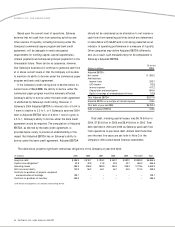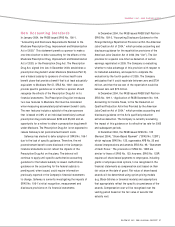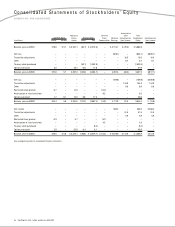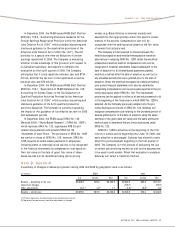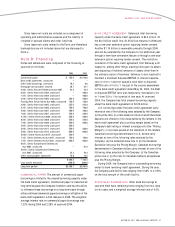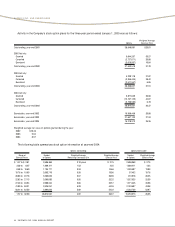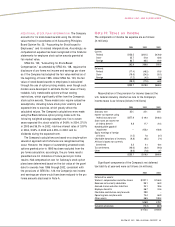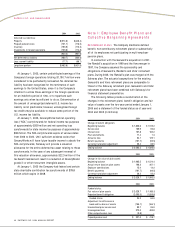Safeway 2004 Annual Report Download - page 38
Download and view the complete annual report
Please find page 38 of the 2004 Safeway annual report below. You can navigate through the pages in the report by either clicking on the pages listed below, or by using the keyword search tool below to find specific information within the annual report.
36 SAFEWAY INC. 2004 ANNUAL REPORT
SAFEWAY INC. AND SUBSIDIARIES
Promotional allowances make up nearly three-quarters of
all allowances. With promotional allowances, vendors pay
Safeway to promote their product. The promotion may be any
combination of a temporary price reduction, a feature in print
ads, a feature in a Safeway circular, or a preferred location in
the store. The promotions are typically one to two weeks long.
Slotting allowances are a small portion of total allowances
(typically less than 5% of all allowances). With slotting
allowances, the vendor reimburses Safeway for the cost
of placing new product on the shelf. Safeway has no
obligation or commitment to keep the product on the shelf
for a minimum period.
Contract allowances make up the remainder of all
allowances. Under a typical contract allowance, a vendor
pays Safeway to keep product on the shelf for a minimum
period of time or when volume thresholds are achieved.
Prior to the adoption of Emerging Issues Task Force
(“EITF”) No. 02-16, slotting allowances were considered a
reimbursement of Safeway’s costs and recognized when the
product was first stocked which is generally the point at
which all the related expenses have been incurred. Promotional
allowances were recognized when the promotion ran.
Beginning with the adoption of EITF No. 02-16 in the first
quarter of 2003, slotting and promotional allowances are
accounted for as a reduction in the cost of purchased
inventory and recognized when the related inventory is sold.
Contract allowances are recognized as a reduction in the
cost of goods sold as volume thresholds are achieved or
through the passage of time.
USE OF ESTIM ATES The preparation of financial
statements in conformity with accounting principles
generally accepted in the United States of America requires
management to make estimates and assumptions that
affect the reported amounts of assets and liabilities and
disclosure of contingent assets and liabilities at the date of
the financial statements, and the reported amounts of
revenues and expenses during the reporting period. Actual
results could differ from those estimates.
TRANSLATION OF FOREIGN CURRENCIES Assets and
liabilities of the Company’s Canadian subsidiaries and Casa
Ley are translated into U.S. dollars at year-end rates of
exchange, and income and expenses are translated at average
rates during the year. Adjustments resulting from translating
financial statements into U.S. dollars are reported, net of
applicable income taxes, as a separate component of
comprehensive income in the consolidated statements of
stockholders’ equity.
CASH AND CASH EQUIVALENTS Short-term investments
with original maturities of less than three months are
considered to be cash equivalents.
MERCHANDISE INVENTORIES Merchandise inventory of
$1,943 million at year-end 2004 and $1,903 million at year-
end 2003 is valued at the lower of cost on a last-in, first-out
(“LIFO”) basis or market value. Such LIFO inventory had a
replacement or current cost of $1,992 million at year-end 2004
and $1,967 million at year-end 2003. Liquidations of LIFO
layers resulted in income of $2.3 million in 2004, expense of
$1.9 million in 2003 and income of $5.3 million in 2002. All
remaining inventory is valued at the lower of cost on a first-
in, first-out (“FIFO”) basis or market value. The FIFO cost of
inventory approximates replacement or current cost. Physical
inventories are taken on a cycle basis. The Company records
an estimated inventory shrink adjustment for the period
between the last physical inventory and the balance sheet date.
PROPERTY AND DEPRECIATION Property is stated at cost.
Depreciation expense on buildings and equipment is computed
on the straight-line method using the following lives:
Stores and other buildings 7 to 40 years
Fixtures and equipment 3 to 15 years
Property under capital leases and leasehold improvements
are amortized on a straight-line basis over the shorter of the
remaining terms of the lease or the estimated useful lives
of the assets.
SELF-INSURANCE The Company is primarily self-insured
for workers’ compensation, automobile and general liability
costs. The self-insurance liability is determined actuarially,
based on claims filed and an estimate of claims incurred but
not yet reported, and is discounted using a risk-free rate of
interest. The present value of such claims was calculated
using a discount rate of 3.25% in 2004 and 3.0% in 2003.
A summary of changes in Safeway’s self-insurance
liability is as follows (in millions):
2004 2003 2002
Beginning balance $409.5 $340.6 $320.4
Expense 247.4 235.2 166.5
Claim payments (158.0) (166.3) (146.3)
Ending balance $498.9 $409.5 $340.6
Less: current portion (142.9) (124.7) (119.5)
Long-term portion $356.0 $284.8 $221.1


